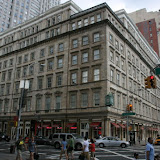Monday, September 14, 2009
Pulp Mag Editorial Offices I Aug 2008
The Frank A Munsey company of 280 Broadway published Argosy, All-Story, Cavalier, Famous Fantastic Mysteries and Fantastic Novels magazines among others. Munsey invented the pulp magazine when he took a boys magazine, The Golden Argosy, substituted cheap pulps paper, changed to general fiction and vastly dropped the price. Circulation for Argosy alone soon topped 1 million and the magazine was published on a weekly schedule. Columbia Publications of 241 Church St published Future, Science Fiction Quarterly, Dynamic, Double Action Detective, Double Action Western and many others. The editor was the great Robert W Lowndes, a former SF fan. Lowndes at one point edited 18 magazines. Unfortunately, Columbia was a bottom feeder among the pulps, paying ½ cent a word as opposed to the general pulp rate of 1 cent a word (Argosy, Blue Book and others paid much more). The fiction published by Lowndes was generally crappy but he had absolutely great editorials, articles and letter columns. Many great articles by L Sprague De Camp and others that have never been republished. Weird Tales needs no introduction. It ended its days at Rockefeller Center but during its heyday, in the 1930’s, it was published at 303 Fourth Ave (Now called Park Ave South). The Fourth Ave location would have been the location that H P Lovecraft and his circle would have visited when they were in town. Galaxy and If were edited by the great Fred Pohl at 421 Hudson St I decided to take photos of the buildings that housed the pulp publishers and environs, if they still remained, after reading about the initial experiences of some pulp authors who visited various publishing houses in New York One amusing article, An Old Cowhand Comes To New York by Chuck Martin (Carlos Martinez) was published in Writers Digest in February 1947. Chuck was a native of Southern California and had published an average of 50 stories a year for 25 years and finally decided to personally see the editors and the city that they worked in. I quote: “ I took a cab downtown and the driver asked me if I was with the trick at Madison Square Garden. Just to be agreeable, I told him that I was with the Rodeo. I wonder how he knew? I was dressed just like I do at home in the same old Stetson and cowboy boots, frontier pants and gabardine shirt. Those New Yorkers looked funny to me. Most of them don’t even wear hats. I checked in at the hotel, washed up some, and went out to a bait of hot grub. Now in Los Angeles or San Diego, if you try to cross against the traffic lights, it costs you five bucks. But in New York no one pays any attention to the lights. So there I was stuck on a narrow curb in the middle of Times Square, waiting for the light to change. A little hand gripped me firmly by the arm. I was hustled through the roaring traffic, dodging honking cars, but at last we made it. And you can hog-tie me for a leppy if there wasn’t the sweetest old lady about seventy years of age, still gripping my arm, and boosting me to the curb! But I learn quick colleagues. From then on I was able to cross the streets alone. Chuck (and Henry Kuttner in another article) describe their first visits to many of the pulp publishers in the city. Most of the publishers are long gone but I wanted to see if the buildings were still there and take pictures. I only hit 4 of the publishers this time around but more will be coming.
Subscribe to:
Post Comments (Atom)

No comments:
Post a Comment